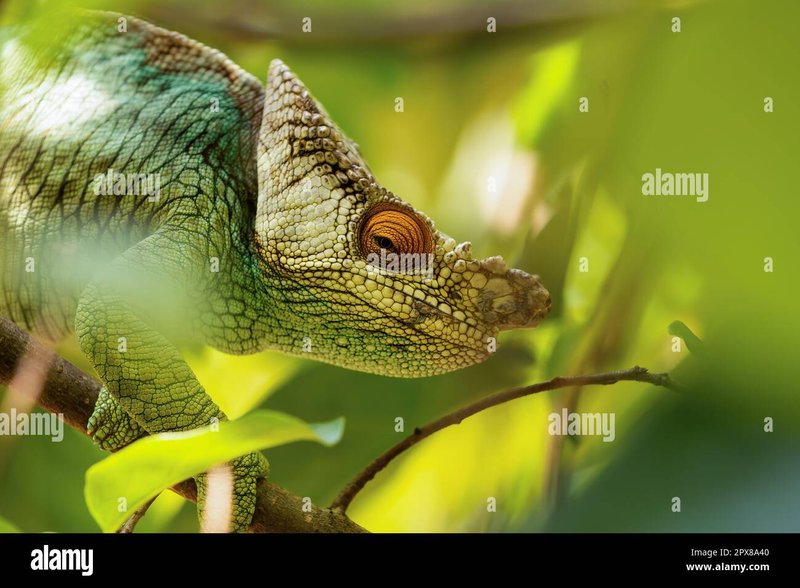
Now, caring for a Parson’s Chameleon isn’t as simple as tossing it into a terrarium and hoping for the best. It’s more like tuning an instrument; if one string is off, the whole melody can fall apart. Understanding their temperature and humidity needs is crucial for their health and well-being. So, grab your favorite drink, and let’s dive into the world of Parson’s Chameleons!
The Basics of Temperature for Parson’s Chameleons
To kick things off, let’s talk about temperature. Just like you enjoy a warm bath on a cold day, Parson’s Chameleons also prefer specific temperature ranges. They thrive in a habitat where the basking area reaches around 85°F to 95°F (29°C to 35°C). This warm spot mimics the sunny environments they naturally inhabit on the lush islands of Madagascar.
But here’s the kicker: not all parts of their space should be hot. In fact, it’s essential to create a temperature gradient in the terrarium, with cooler areas hovering around 70°F to 80°F (21°C to 27°C). You might wonder, why is that? Well, these chameleons need to regulate their body temperature by moving between warmer and cooler spots. So, it’s like having a sunny patio and a shaded nook—variety is key!
Keeping a close eye on the temperature can be done easily with a thermometer. You can find digital ones that provide accurate readings without much hassle. It’s a small investment that can save your chameleon from stress and health issues.
Humidity Levels Matter
Next up is humidity. This is where things get a little more delicate. Parson’s Chameleons thrive in a humid environment, ideally between 50% to 70% humidity. Think of humidity as the air’s way of keeping moisture available for your chameleon, like a soft fog rolling through a forest.
To maintain those levels, regular misting is essential. Using a spray bottle, you can mist the enclosure a couple of times a day. Or, if you want to kick things up a notch, consider an automatic misting system. This solution saves time and ensures consistency. Some people even use a humidifier to help achieve those perfect moisture levels, especially if they live in a dry climate.
Additionally, it’s worth noting that plant life can help maintain humidity. Adding live plants not only elevates the aesthetic, but they also release moisture into the air, creating a more natural habitat. Just keep an eye on the humidity levels with a hygrometer to ensure you’re on track.
Day and Night Temperature Variations
You might be wondering, how does temperature change from day to night? It’s essential for the health of your chameleon! During the night, temperatures should dip slightly—not too much, though. A range of about 60°F to 70°F (15°C to 21°C) is perfect. These slight drops in temperature mimic their natural habitat and encourage a natural sleep cycle.
If your chameleon is kept in an environment that is too warm at night, it might disrupt their sleep patterns. You wouldn’t feel too great if your bedroom stayed toasty all night long, right? Installing a night heat bulb or a ceramic heat emitter can safely keep temperatures within that ideal range without disturbing their slumber.
Signs of Temperature Stress
It’s crucial to recognize when your Parson’s Chameleon isn’t happy with its temperature. Signs of temperature-related stress can manifest in various ways:
- Color Changes: If your chameleon turns dark or dull, it may be trying to absorb more heat.
- Inactivity: A lethargic chameleon that stays in one spot may be too cold.
- Excessive Basking: If it’s constantly under the basking light, it could be trying to warm up.
- Rapid Breathing: This can indicate overheating or stress.
Being observant and responsive to these signs can help you adjust the environment quickly. It’s all about keeping your chameleon as comfortable as possible!
Creating the Ideal Habitat
So, what goes into creating this perfect environment? First, you’ll need a spacious terrarium—at least 4 feet tall to allow for climbing. Chameleons love vertical space! Decorate it with branches, vines, and plants, providing plenty of climbing opportunities. Live plants add humidity, but even artificial ones can serve a purpose if you’re up for the challenge.
You’ll also want to include multiple basking spots at different heights. Use a heat lamp to provide the necessary warmth over these spots, while ensuring that the cooler areas are free from excessive light. Think of it as setting up a cozy lounge and a warm nook for your chameleon.
Don’t forget about proper ventilation! Chameleons need fresh air circulating to thrive, so leave some openings in the terrarium while placing decorations strategically to ensure airflow without making it too drafty.
Monitoring and Adjusting the Environment
Maintaining the perfect temperature and humidity requires ongoing monitoring. It may seem tedious, but it’s like keeping track of your plants at home. You’ll want to check the thermometer and hygrometer daily to make adjustments as needed. If you notice fluctuations outside the ideal range, don’t hesitate to tweak the misting schedule or adjust the heat sources.
Investing in smart technology like temperature and humidity controllers can also be a game-changer. These devices can automatically adjust factors in the terrarium based on real-time readings, making your job a lot more manageable.
Sometimes it takes a bit of trial and error to find the sweet spot, but every small adjustment leads to a happier, healthier chameleon.
In conclusion, keeping a Parson’s Chameleon happy and healthy requires a keen understanding of their temperature and humidity needs. By providing a warm basking area, a cooler space to retreat to, and maintaining ideal humidity levels, you create a thriving environment for your new pet. Yes, it may take a bit of effort at the start, but your chameleon will reward you with vibrant colors and playful antics.
Remember, the key is to pay attention and adjust as needed. Just like a well-tended garden, a little nurturing goes a long way! So, equip yourself with the right tools, stay observant, and enjoy the wonderful journey of chameleon care. Trust me, it’s worth every moment!

